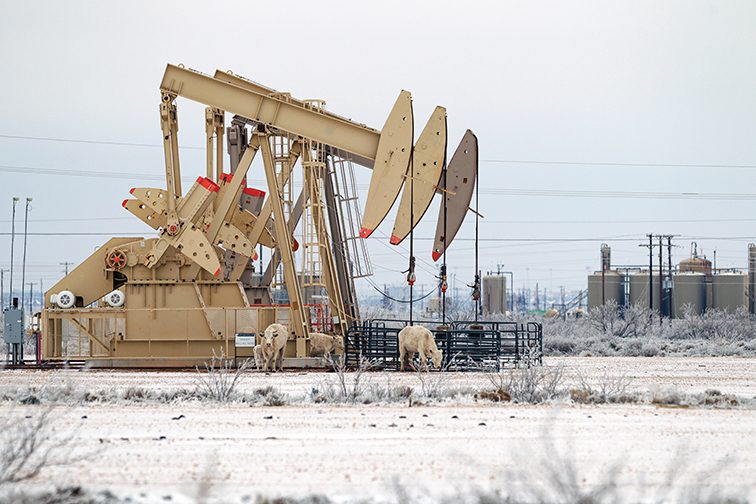A polar vortex that invaded deep into the Southern U.S. hit freight volumes hard in February. Travel was halted on icebound Texas highways, oil and gas pipelines froze, and electricity was knocked out in much of the state as record cold temperatures lasted for nearly a week.
A return of good weather, a growing vaccination program and a new round of economic impact payments from the federal government created optimism for better months to come.
The American Trucking Associations (ATA) said truckload tonnage reported by member carriers fell 4.5% in February after gaining 1.8% in January. The For-Hire Truck Tonnage Index, which compares monthly tonnage volumes with averages from the year 2015 (2015=100), came in at 110 for February, down from 115.2 in the prior month.
The February result represented a 5.9% decline from February 2020, when the COVID-19 pandemic was just getting started.
Bad weather got the blame. “February’s drop was exacerbated, perhaps completely caused, by the severe winter weather that impacted much of the country during the month,” said Bob Costello, chief economist for ATA, in a March 23 statement. “Many other economic indicators were also soft in February due to the bad storms, but I continue to expect a nice climb up for the economy and truck freight as economic stimulus checks are spent and more people are vaccinated.”
Cass Information Systems (cassinfo.com) reported a seasonally adjusted decline in freight volume in February, also blaming the weather event. The Cass Freight Index, which measures shipments across multiple modes of transport including truck, rail, ship, barge and pipeline, reported that shipment numbers declined 3.2% from January volumes. The decline negated a 3% increase in January.
However, Cass reported that February volumes were 4.1% higher compared to the same month in 2020. That rate was less than half of the 8.6% increase in January-over-January 2020 results.
Tim Denoyer, vice president and senior analyst at ACT Research and writer of the Cass report, thinks the setback is temporary. “The significant supply side issues will only temporarily belie the strong demand environment, and considerable acceleration in freight demand is still most likely,” he wrote.
Denoyer pointed out that March, April and May 2020 saw the biggest hits to shipping as manufacturing shut down around the globe. “With much easier prior-year comparisons ahead, if the Cass shipments index just takes a normal seasonal pattern from here, it will be up over 25% year over year in Q2,” he stated.
A potential fly in the ointment, Cass reported, is the current shortage of semiconductors and other vehicle parts that has resulted in a slowdown in production of trucks and automobiles, along with other products. Even if products are available to haul, carriers will have difficulty taking delivery of new trucks and hiring drivers to operate them. As the economy continues to reopen, however, the parts pipeline should begin operating smoothly again.
In his March 22 “Monday Morning Coffee” blog for FTR, writer Steve Graham pointed out that February weather impacted industrial production, which fell 2.2% in the month. He cites a 5.4% decline in mining and a 3.1% drop in manufacturing as key factors in the production drop.
While the amount of freight hauled was subdued in February, the rates paid to haul it continued to rise. According to reports from DAT Trendlines (dat.com/industry-trends/trendlines), national average spot freight rates on their load board climbed to $2.40 per mile, gaining back some of the January declines. Refrigerated rates rose to $2.69 per mile, the best of the year so far, and flatbed rates rose to $2.56 per mile.
Rates for all three modes rose considerably higher as March unfolded. DAT’s Trendlines report said the flatbed sector is experiencing “the tightest capacity we’ve seen since the Great Recession.”
DAT also reported that the February ratio of loads to trucks was 29.7% higher than in January, and a whopping 206.1% higher than February 2020, a sign that rates will continue climbing.
A separate report from DAT, the “2021 Freight Focus” publication, noted that the percentage of freight moved on the spot market grew substantially in 2020, from about 13% of truckload freight hauled in previous years to nearly 22%. Surging e-commerce business was credited with major supply-chain changes, causing shippers to turn to the spot market to find capacity.
One might expect that freight could return to “normal” as the economy reopens, but many employers who have discovered the advantages of work-from-home employees may permanently alter their staffing strategies. With fewer employees in the office, companies spend less on real estate, office furniture, maintenance and even parking. The surge in e-commerce that resulted from people staying at home may continue for quite some time.
How quickly the economy reopens hinges largely on the speed at which COVID-19 vaccinations are administered to the population. President Joe Biden has pledged that vaccine will be available for all adults in the U.S. population by the end of May, which could bring the hoped-for “herd immunity” sooner than expected. Some states, such as Texas, Mississippi and Florida, have removed COVID-19 restrictions from their populations, a move Biden termed “reckless.” If a resurgence in COVID-19 cases occurs, restrictions could be reimposed, but for now the country is gradually getting back to pre-COVID-19 business practices.
Freight levels are expected to continue growing. Carriers are confident there will be plenty of freight to haul and are ordering new trucks at a level that has created an eight-month backlog of new truck orders.
Freight rates are expected to continue rising as carriers can’t buy trucks to expand fleets and can’t find enough qualified drivers to drive the trucks already in their fleets.
Rising diesel fuel prices could dampen the enthusiasm, but recent increases have brought fuel prices within a dime per gallon of where they were prior to the pandemic. As March came to a close, the U.S. Energy Information Administration’s (EIA) weekly fuel price update reported the first decline in the national average price for a gallon of diesel fuel since election week in November, 2020, following a stretch of 21 consecutive weeks of price increases.
All in all, the next few months should be good ones for trucking.
Cliff Abbott is an experienced commercial vehicle driver and owner-operator who still holds a CDL in his home state of Alabama. In nearly 40 years in trucking, he’s been an instructor and trainer and has managed safety and recruiting operations for several carriers. Having never lost his love of the road, Cliff has written a book and hundreds of songs and has been writing for The Trucker for more than a decade.















